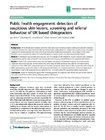| dc.contributor.author | Bristow, Ivan | |
| dc.contributor.author | Bowen, Catherine | |
| dc.contributor.author | Wilson, Nicky | |
| dc.contributor.author | Borthwick, Alan | |
| dc.date.accessioned | 2024-04-16T11:03:34Z | |
| dc.date.available | 2024-04-16T11:03:34Z | |
| dc.date.issued | 2023-07-04 | |
| dc.identifier.citation | Bristow, I., Bowen, C., Wilson, N., & Borthwick, A. (2023). Independent prescribing in the UK: insights from the Department of Health Allied Health Professions Medicines Project team. Journal of Foot and Ankle Research, 16(1), 41. https://doi.org/10.1186/s13047-023-00641-z | en |
| dc.identifier.issn | 1757-1146 | |
| dc.identifier.uri | https://aecc.archive.knowledgearc.net/handle/123456789/294 | |
| dc.description | Available under License - Creative Commons Attribution: https://creativecommons.org/licenses/by/4.0/ | en |
| dc.description.abstract | Background: The UK medicines legislation was amended ten years ago (2013) to allow podiatrists and physiotherapists independent prescribing rights, the first of the allied health professions to do so. Non-medical prescribing formed one part of a broader policy agenda promoting role flexibility in response to the challenge of an ageing population and the need to maintain effective health provision in the face of a contracting workforce.
Aim: The aim of this study was to outline the experiences of the Department of Health AHP medicines project board team in working towards independent prescribing for podiatry and physiotherapy, with a particular focus on the challenges encountered.
Methods: In depth, open-ended interviews were conducted with eight of the core members of the project team, drawn from those individuals who served throughout the duration of the project (2010–2013). Included were the former Department of Health Chief and Deputy Chief Allied Health Professions Officers; the Department of Health Engagement and Communications Officer; representatives of the Health and Care Professions Council; the Medicines and Healthcare products Regulatory Agency; the Council of Deans of Health; the Royal College of Podiatry and the Chartered Society of Physiotherapy (The team also included the representative of the Allied Health Professions Federation. However, as that representative is also a researcher in this study, he has recused himself from any role as a participant.). Data were transcribed and subject to a thematic analysis.
Results: A complex picture of the project emerged revealing a range of obstacles and challenges, including inter-professional role boundary tensions and negative prior assumptions about the two professions. Success hinged upon the adoption of a dual strategy involving submission of a robust case of need focused on patient benefit coupled with the careful management of professional expectations. Underpinning theory from the sociology of the professions offers a supportive explanatory framework for understanding the relationships between the various stakeholders involved.
Conclusions: Ultimately, success depended upon aligning the project aims with healthcare policy through a clear focus on patient benefit. Balancing competing professional and policy demands through a continual emphasis on improved patient care laid the foundations for future projects by other allied health professions. | en |
| dc.language.iso | en | en |
| dc.publisher | Journal of Foot and Ankle Research | en |
| dc.subject | Department of health | en |
| dc.subject | Allied health professions | en |
| dc.subject | Medicines | en |
| dc.subject | Commission on human medicines | en |
| dc.subject | Medicines and healthcare products regulatory agency | en |
| dc.subject | Health and care professions council | en |
| dc.subject | Patients | en |
| dc.subject | Workforce | en |
| dc.subject | Service redesign | en |
| dc.title | Independent prescribing in the UK: insights from the Department of Health Allied Health Professions Medicines Project team | en |
| dc.type | Article | en |
| dc.identifier.doi | https://doi.org/10.1186/s13047-023-00641-z | |



